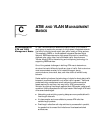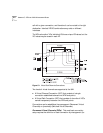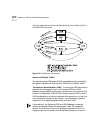
C-6 APPENDIX C: ATM AND VLAN MANAGEMENT BASICS
Integrated ATM/Ethernet Switching
ATM Backbone Network When Ethernet LANs are connected through
a conventional switching hub or backbone, the bandwidth provided is
restricted to the data rate of the Ethernet or FDDI technology running on
it. If, instead, the Ethernet LANs are connected through an ATM
backbone switch - creating an integrated ATM/Ethernet network - the
bandwidth bottleneck is opened up and performance is increased across
the combined network. The Ethernet switches pass only those messages
whose sender and receiver are in separate Ethernet LANs to the ATM
Switch, thereby reducing the message traffic on the combined system.
Furthermore, the high-speed switching rate and efficient time-utilization
of ATM are responsible for the high throughput of the ATM/Ethernet
network system.
The ATM/Ethernet network system also opens new possibilities in
network design. Instead of being restricted to LANs, whose users are
connected by a physical cable, new efficient LANs can be created which
cross physical LAN boundaries. The sophisticated address handling of
ATM allows related users in separate physical LANs to be effectively
grouped into a common broadcast domain called a Virtual LAN. Virtual
LANs are described in the next section.
Virtual LAN Basics Just as an Ethernet LAN enables a group of stations to communicate
efficiently on a common physical bus, so new networking technology
such as ATM makes it possible for stations on different LANs to
communicate with almost the same efficiency, even when separated by
great distances. This allows network managers to group remote stations
that need to communicate frequently into a common high-bandwidth
broadcast domain called a Virtual LAN. For example, marketing
department personnel who happen to work in different physical locations
could be formed into one Virtual LAN and engineering department
personnel into another. The term “Virtual LAN” is used because
communicating stations continue to transmit and receive as though they
were on the same physical Ethernet LAN. In this manual, the abbreviated
expression “VLAN” is used for a Virtual LAN.
Supported by signaling standard Supported by MIB or other
management entity
Table C-2 Comparison of SVC and PVC
SVC PVC


















